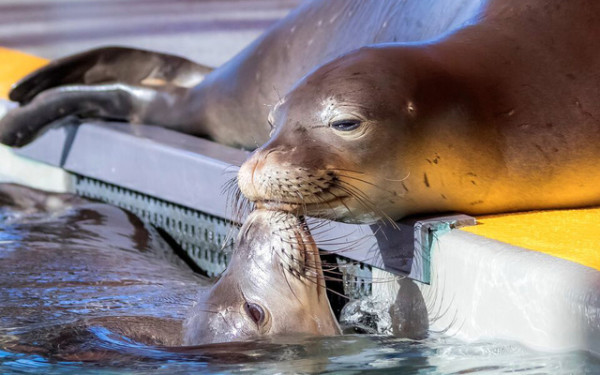Published in the Ocean Watch column, Honolulu Star-Advertiser © Susan Scott
March 14, 2016
In 2014 I heard that a monk seal hospital opened on Hawaii island’s Kona Coast. I didn’t know any more about it until a year later when I picked up a friend returning from Midway Atoll. His seatmates on the plane had been two monk seal pups found at Pearl and Hermes Atoll in Papahanau- mokuakea National Marine Monument.
The curious and adorable youngsters, each resting in its own crate, sniffed us human admirers before workers whisked the babies away. The hungry pups, abandoned by their mothers, were going to Ke Kai Ola, Hawaii’s monk seal hospital.
 Monk seal pups Pearl and Hermes are nearly back to full strength at Ke Kai Ola.
Monk seal pups Pearl and Hermes are nearly back to full strength at Ke Kai Ola.
Courtesy Julie Steelman / NOAA 16632-00-932-1905-01MA-009526-1
The next time I’m on the Big Island, I vowed, I’m going to this place and see what it’s about. The time arrived. During my visit last week, I learned that Ke Kai Ola is an arm of the Marine Mammal Center, a nonprofit veterinary research hospital and educational facility in Sausalito, Calif. Its Kona branch is in the Natural Energy Laboratory of Hawaii Authority, a site where deep, pristine seawater is available for various projects.
Hospital manager Deb Wickham welcomed me warmly. Deb showed me not only an education center, but a state-of-the-art operating room, a kitchen to prepare seal meals, the water circulation system and four saltwater recovery pools.
We talked in the building’s central office, which looks like a miniature mission control.
To prevent recuperating seals from becoming accustomed to people, hospital staff don’t let the seals see them more than necessary. Four closed-circuit cameras provide live coverage of the pools, enabling workers to observe the seals’ activity on large monitors.
A one-way window also lets caregivers watch the seals’ behavior undetected.
In its 21 months of operation, Ke Kai Ola has rehabilitated 15 injured, sick and emaciated monk seals. With 1,200 Hawaiian monk seals left in the world, that’s a significant 1 percent of the population.
Monk seals spend two-thirds of their time at sea, hunting for fish, lobster and octopus. When not hunting, seals nap on sandy beaches and rocky shores. If you see a monk seal, stay at least 50 yards away and, please, be quiet. Let the tired animal rest.
I was happy to learn that the pups I met at the airport, named Pearl and Hermes, are fat, healthy and will soon go back to their ocean home. Five other recovered monk seals are also nearly ready to go.
I enjoyed visiting this place of healing and discovering what it’s about. This gift to Hawaii’s seals, one of the rarest seal species on Earth, is about caring.
As a nonprofit group, Ke Kai Ola needs volunteers and donations. To contribute go to marinemammalcenter.org. It’s a great way to show that we care.